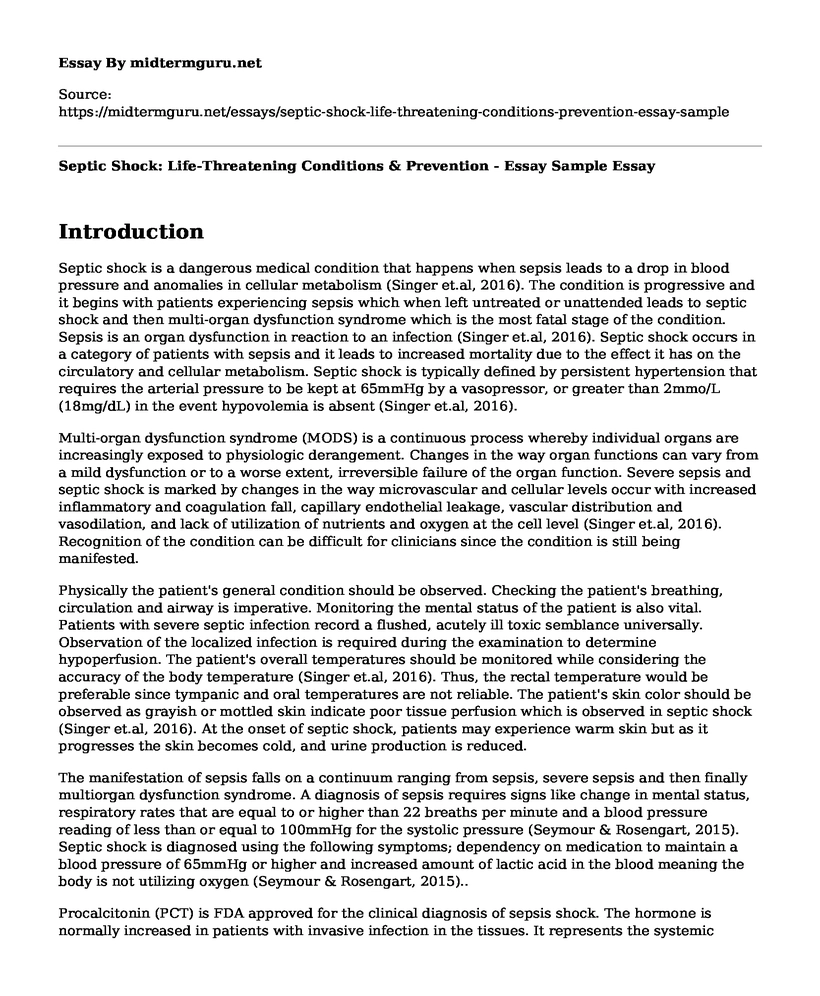Introduction
Septic shock is a dangerous medical condition that happens when sepsis leads to a drop in blood pressure and anomalies in cellular metabolism (Singer et.al, 2016). The condition is progressive and it begins with patients experiencing sepsis which when left untreated or unattended leads to septic shock and then multi-organ dysfunction syndrome which is the most fatal stage of the condition. Sepsis is an organ dysfunction in reaction to an infection (Singer et.al, 2016). Septic shock occurs in a category of patients with sepsis and it leads to increased mortality due to the effect it has on the circulatory and cellular metabolism. Septic shock is typically defined by persistent hypertension that requires the arterial pressure to be kept at 65mmHg by a vasopressor, or greater than 2mmo/L (18mg/dL) in the event hypovolemia is absent (Singer et.al, 2016).
Multi-organ dysfunction syndrome (MODS) is a continuous process whereby individual organs are increasingly exposed to physiologic derangement. Changes in the way organ functions can vary from a mild dysfunction or to a worse extent, irreversible failure of the organ function. Severe sepsis and septic shock is marked by changes in the way microvascular and cellular levels occur with increased inflammatory and coagulation fall, capillary endothelial leakage, vascular distribution and vasodilation, and lack of utilization of nutrients and oxygen at the cell level (Singer et.al, 2016). Recognition of the condition can be difficult for clinicians since the condition is still being manifested.
Physically the patient's general condition should be observed. Checking the patient's breathing, circulation and airway is imperative. Monitoring the mental status of the patient is also vital. Patients with severe septic infection record a flushed, acutely ill toxic semblance universally. Observation of the localized infection is required during the examination to determine hypoperfusion. The patient's overall temperatures should be monitored while considering the accuracy of the body temperature (Singer et.al, 2016). Thus, the rectal temperature would be preferable since tympanic and oral temperatures are not reliable. The patient's skin color should be observed as grayish or mottled skin indicate poor tissue perfusion which is observed in septic shock (Singer et.al, 2016). At the onset of septic shock, patients may experience warm skin but as it progresses the skin becomes cold, and urine production is reduced.
The manifestation of sepsis falls on a continuum ranging from sepsis, severe sepsis and then finally multiorgan dysfunction syndrome. A diagnosis of sepsis requires signs like change in mental status, respiratory rates that are equal to or higher than 22 breaths per minute and a blood pressure reading of less than or equal to 100mmHg for the systolic pressure (Seymour & Rosengart, 2015). Septic shock is diagnosed using the following symptoms; dependency on medication to maintain a blood pressure of 65mmHg or higher and increased amount of lactic acid in the blood meaning the body is not utilizing oxygen (Seymour & Rosengart, 2015)..
Procalcitonin (PCT) is FDA approved for the clinical diagnosis of sepsis shock. The hormone is normally increased in patients with invasive infection in the tissues. It represents the systemic response of cells affected by sepsis (Seymour & Rosengart, 2015). Alternatively, a patient's clinical history can be used to diagnose the condition or through assessment by a physician. Lactate level is also used as a criterion of diagnosis.
It is imperative to observe hypoperfusion in sepsis patients as it may lead to multiple organ dysfunction. Early detection will, therefore, make the management of patients with sepsis and septic shock easier and avoid further complications (Davis et.al, 2017). Hemodynamic monitoring is used to gauge hemodynamic instabilities and how patients respond to therapy.
References
Davis, A. L., Carcillo, J. A., Aneja, R. K., Deymann, A. J., Lin, J. C., Nguyen, T. C., ... & Stojadinovic, B. J. (2017). American College of Critical Care Medicine clinical practice parameters for hemodynamic support of pediatric and neonatal septic shock. Critical care medicine, 45(6), 1061-1093.
Seymour, C. W., & Rosengart, M. R. (2015). Septic shock: advances in diagnosis and treatment. Jama, 314(7), 708-717.
Singer, M., Deutschman, C. S., Seymour, C. W., Shankar-Hari, M., Annane, D., Bauer, M., ... & Hotchkiss, R. S. (2016). The third international consensus definitions for sepsis and septic shock (Sepsis-3). Jama, 315(8), 801-810.
Cite this page
Septic Shock: Life-Threatening Conditions & Prevention - Essay Sample. (2023, Jan 03). Retrieved from https://midtermguru.com/essays/septic-shock-life-threatening-conditions-prevention-essay-sample
If you are the original author of this essay and no longer wish to have it published on the midtermguru.com website, please click below to request its removal:
- Essay on New Drug for the Treatment of Lewy Body Dementia
- Paper Example on Preventing Healthcare Associated Diseases
- Nutrition Science and Its Benefits: Beyond Weight Management - Essay Sample
- Maximizing Professional & Personal Effectiveness for Healthcare Practitioners - Essay Sample
- Abortion: Common, Safe, Yet Criminally Prohibited in Australia - Essay Sample
- CPOE: Enhancing Patient Safety & Reducing Errors in Healthcare - Essay Sample
- Disability Service Providers: A History of Successful Support Services - Essay Sample







